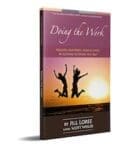What Are We Fighting For?

Unlike the Little-L Lower Self who cowers behind a feeling of “I can’t,” the Big-L Lower Self digs in its heels and says: “I won’t”. Its signature move is to be destructive, and it doesn’t care if our behavior works against our own best interest. It feels most alive when latched onto an energy current that supports its negative intention. Perhaps the harshest reality about this part of ourselves is its penchant for out-and-out cruelty, both to ourselves and to others. Harsher yet: we like it.
Yes, believe it or not, we enjoy our negativity. For those who haven’t yet worked their way into the deeper end of the pool, this may seem hard to believe. But in truth, the reality that we get so much pleasure from our cruelty is the reason we won’t give it up. With our present-day backwards wiring, we find our connection to our life force through our life-destroying ways. And until we are ready to face the fact that this is the temporary but current truth of who we are—in the Lower-Self layer of our being—we won’t be willing or ready to give it up.
Our work, then, requires we learn to reorient our will so that we start identifying and challenging our own Lower Self as it operates today. We must learn to recognize the ways in which we access our life force by getting pleasure from being destructive or cruel. We must learn to pray for help from our own Higher Self so we will have the courage needed to fight the good fight, and take on this formidable foe.
For the Big-L Lower Self is no slouch. As good and creative and smart and clever as we are in the best parts of ourselves—in our Higher Self—that’s how crafty and conniving and slippery we are in the worst—in our Lower Self. We need to catch on to the Lower-Self script running in the background of our beings so we can follow the best approach for cleaning ourselves up.

When we start to do this work, we will begin to understand there is a sizable gap between what we think with our conscious mind and what’s really going on under the surface of our awareness. Remember, the unconscious is the repository of all the faulty conclusions we’ve drawn about life that don’t hold up to adult scrutiny. So they’ve sunk down out of sight where they fester and foul up the works.
In our conscious minds, we may be perfectly clear that what we want in life is some variety of happiness and peace. And whatever we think will bring us this could be ours, if it weren’t for one small problem: we have an opposite viewpoint operating behind the scenes. If that weren’t so, we would already have our heart’s desire.
Often, we want something so badly we think this is proof of our true desire. In fact, what this usually points up is the presence of an underground counter-motion going in exactly the opposite direction. For example, if we feel we want to find a loving partner in life, and especially if we feel a sense of urgency about wanting this, there is likely a hidden inner part of us fleeing in the other direction. That part is holding some kind of belief like “I don’t matter enough for the people I love to stay.”
If we don’t surface these hidden aspects, with their frantic energy and anxious behavior, we’ll continue to manifest partners in life who, what do you know, don’t stay. Beyond this, we’ll show up in ways that will assure that this is so. All the while, we’re scratching our heads. Because we don’t understand what makes us behave the way we do, acting in a manner that drives people away.
If we follow the thread of our child logic, we may be able to see that in this hidden-away part of ourselves, we believe we are avoiding pain by not letting someone get close—especially since we secretly believe they will eventually leave and hurt us anyways. But what, in fact, is a likely reason someone might leave? They feel they can never get close to us. Now we start to get a sense of the real problem.
From here, it will take some work for us to start letting go, taking a risk to let our guard down and let someone in. But we’ll need someone to help guide our way. Because we don’t want to do this from the warped perspective of an immature inner child who believes it’s death to ever get its feelings hurt. Let’s face it, we won’t go from zero to 60 overnight, instantly attracting someone who doesn’t have their own issues yet to resolve. We’ll find someone with whom we are sure to at least occasionally stub our toes.
We must learn that this is life and it’s not perfect. Sometimes we will get hurt. We will attract people to us exactly because they are a great mirror for us. When they show us where our work is, that will be an opportunity for us to face some aspect of ourselves we haven’t yet wanted to see.
This is the gift of relationship and it’s not always fun. This is also why the Guide refers to relationships as a “path within a path.” They will bring up our stuff, and God bless them for this.
In Jill’s Experience
I’ve come to realize that reason for my inner running shoes is hate. This feels like Big-L energy that wants to make someone pay for what they’ve done to me. When I was little, hate felt like the only tool I had at my disposal. If you don’t care about me, I hate you. And I want to run away. This isn’t something I was consciously aware of until one day I saw hatred leaking sideways out of me. And I realized it was connected to the feeling someone didn’t care about me.
The not-caring issue had to do with my work regarding these very teachings from the Guide. It’s been a long row to hoe, rewriting 100 lectures and compiling them into books that make this material more accessible. But my efforts to have my work recognized by the existing organization have largely fallen on deaf ears. And this has plucked the strings of my images like crazy.
What this has given rise to was a feeling of hatred toward the people and governing body that have a hold on the spiritual teachings I deeply cherish. Now that doesn’t sound very spiritual, does it? At some point in our work though, there is going to be a dying process. In this case, I had to die into the reality that for whatever reason, I wasn’t going to be seen, much less embraced, by the Pathwork Foundation.
Getting over hate looks a lot like the process of forgiveness: we don’t do it for the other guy. No, when we buy into the dark energies of Lower Self, we are colluding with evil. We’re choosing separation instead of connection, and in the end, we’re the ones who feel the pinch.
I don’t hate the Pathwork organization—Hey, I love these teachings!—but that doesn’t mean their behavior towards me doesn’t affect me. That’s the tricky thing about doing this work. We need to be honest in sorting out our Emotional Reactions from the reality that we do affect each other, even when we don’t mean to.
In Scott’s Experience
When I started really doing my work, it began with a daily review. It was really quite simple: take 10 minutes before bed and review the day. Notice the situations that brought disharmony, and jot them down. I did this for three months. Soon it became time to comb through them to create a composite picture of my challenges, to get everything on one page where I could see it.
I found this to be challenging to do. For I simply balked at taking the time to read through three months of my daily review to get a better picture of things. Something in me refused. I prayed for help, because the inner stubbornness wasn’t abating on its own.
About this time, I had to travel to Wilmington, NC on very short notice to support an urgent manufacturing problem on a jet engine part. I traveled on an early spring Thursday and walked into the manufacturing plant on Friday morning at 6 am, only to find it completely empty of people. They shut the plant down for annual maintenance during the first round of the NCAA basketball tournament, and nobody gave me a head’s up. I had to come back Monday morning.
Because it was still off-season, I got a room in a resort hotel on Wrightsville Beach for the weekend. I was given a glorious three-day weekend with hot sun, sand and waves, and all I had to accomplish was this daily review composite. I thought it would be easy to do here on the beach.
Actually, it was really difficult.
I got settled under a beach umbrella. That didn’t work. Then I went to the pool. That wasn’t right. Then I walked the beach to get myself focused, and tried again. Day One: Nothing accomplished. More of the same Saturday, and it was exhausting.
Finally, on Sunday, I made a supreme effort and methodically, somehow, got through it. The list was remarkable in many ways, and one of the things on it was a tendency, sometimes, in certain situations, to stubbornly refuse to get something done. I occasionally had to use a supreme effort of will to get them done. This was puzzling, but undeniable. It was certainly there in my effort to see what was in my daily review notes.
I worked with a Helper to explore these inner places in earnest. A couple years later I was in a group, and I wanted to work with this place in me. The Helper coached me to first feel into the experience on the beach, trying to write. As I did so, he asked me where I felt these experiences in my body. They were in my belly. He asked me to bring my attention there, and to breathe into that space in my belly. I suddenly dropped into an altered consciousness that had a belligerent attitude: “I won’t do this. I. WILL. NOT.”
The Helper talked with this part of me, but I was having none of it. He tried asking how it felt, what it wanted, and so on. I kept expressing this fragmented part of me, saying, “I. WILL. NOT.”
This went on for some time, until the Helper suddenly asked, “What year is it?”
I replied, “1980.”
He said, “Huh. Do you realize it is 2003?”
No, I did not. I refused to budge off “I. WILL. NOT.”
Finally he said, “Ok, you don’t have to. You can stay there. It’s time for me to go.”
This part of me was caught in a bind. It utterly refused to move, but didn’t want to be left behind. Finally, it said, “Wait, don’t go.” And it asked for help to come back to the light.
Afterward, I was a bit shocked at the negative intention of this part of me. Yet it was undeniable. No matter what was asked of it, the answer was a willful “NO!” even if it brought unwanted consequences. That’s what the Big-L Lower Self does. It says No to life. It says, “I won’t.”
The good news is this can skillfully be brought into consciousness and transformed. When that happens, all the energy applied there becomes available again to say Yes to life.
Next Chapter
Return to Doing the Work Contents


